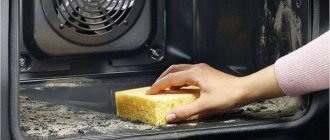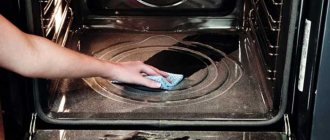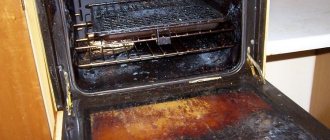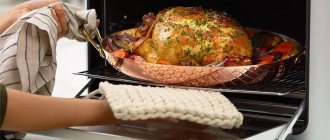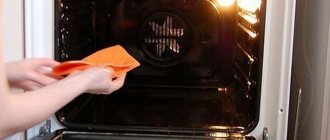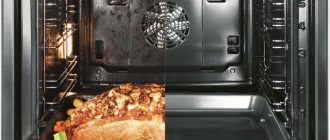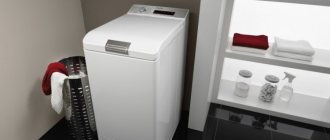The kitchen stove has gone through a long evolution before it acquired the appearance familiar to the modern consumer. At first these were ordinary stone stoves, which were replaced by multifunctional metal devices. Further, at the peak of development of home stoves, popular gas and electric household appliances appeared. Modern technology is a sophisticated multifunctional device equipped with various functions and programs: gas control, timer, grill, convection. One of them is a catalytic purification system. The article will tell you what catalytic oven cleaning is, what its advantages and disadvantages are, as well as its operating features.
Pyrolytic oven cleaning
The term “pyrolysis” in scientific language stands for the thermal separation of organic and inorganic chemical compounds, resulting in the formation of ash and gaseous compounds. This term is made up of two ancient Greek words: Pyr (πῦρ) - fire, heat, bonfire and Lysis (λύσις) - decay, decomposition, stratification. In simple words, the essence of pyrolytic cleaning means the combustion of any contamination that may have formed on the walls of the oven.
The pyrolysis method is so far the most advanced of all existing ones, and an oven equipped with such functionality can safely be classified as a Mercedes among ovens. The fact is that the use of increased temperature automatically means the use of more durable and resistant materials.
Every housewife knows that to prepare the bulk of baked goods, a temperature of 180-250 ° C is required, which means that pyrolysis must be carried out at much higher temperatures, for which standard ovens are simply not designed. Basically, most pyrolytic reactions occur at a temperature of about 500 ° C, although some oven manufacturers have been able to “make” this function work at 300 ° C, but this is not pyrolysis in its pure form, but only part of a multi-level cleaning system.
Since cleaning is carried out at high temperatures, all such ovens are equipped with additional thermal protection for the door and body so that the outside temperature is as low as possible. They are also equipped with a locking mechanism that does not allow the doors to be opened while the temperature inside is above two hundred degrees.
Carrying out the cleaning itself should not cause any difficulties for anyone: all the baking sheets are removed from the oven (in some models this is not necessary - the stands are also made of heat-resistant metal and can be cleaned in this way), the door is closed and the self-cleaning mode is turned on. When the pyrolysis process is completed, you need to wait a while to let the oven cool, after which you can simply sweep away the resulting ash with a brush or rag.
+ Advantages of the pyrolytic cleaning method
- This is in the full sense of the word “self-cleaning of the oven” without human intervention - all that is required is to start pyrolysis and then remove the ashes.
- It is almost impossible to buy a bad oven with a pyrolysis system - only high-quality crucible steel is used for them. Other materials will reveal themselves during the warranty period: the oven will simply “drive” - it will change its shape due to thermal expansion.
- The entire internal surface is cleaned, including the most inaccessible areas - even if the ash does not fall to the bottom from there, it will simply be blown away.
— Disadvantages of the pyrolytic cleaning method
- The use of high-quality materials proportionally increases the cost of the oven.
- Cleaning is carried out separately from food preparation. This means wasted time and additional energy consumption.
- The power of ovens with a pyrolysis system is higher than usual, so in any case you will have to run a separate line for it, designed for at least 6 kW.
- Pyrolysis produces a large amount of gaseous decomposition products, the removal of which requires a good ventilation system.
- Despite high-quality thermal protection, the surface of the oven and the door itself gets quite hot. Although their temperature does not exceed 70-80 °C, this is quite enough to get burned, especially for a child. Therefore, it is advisable that no one is in the kitchen during pyrolysis cleaning of the oven.
How to choose the right one
Catalytic cleaning is considered one of the simplest, so it is customary to select such models based on other criteria - the set of functions, maximum heating temperature, chamber volume, etc.
However, some useful tips from experts will help you avoid mistakes and choose the most successful option:
- catalytic cleaning is suitable for users who plan to frequently cook at high temperatures. To prepare delicate dishes at a relatively low temperature, it is better to choose hydrolytic models;
- catalytic panels can be installed only on the back wall, or on the entire internal surface of the cabinet (except for the door and bottom). It is recommended to choose the most secure models;
- It must be remembered that milk or sugar streaks not only remain on the surface, but also damage the panel. Therefore, for baked goods and other dessert-type products, it is better to purchase models with a different type of cleaning;
- There are different brands of catalytic enamel. It is recommended to choose an oven with an EcoClean system, which is highly durable and can restore its performance to some extent.
It will be useful to get advice from the seller and carefully study the instructions for the oven. This will not take too much time, but will give the most reliable answers to all questions that arise.
Catalytic oven cleaning
When using this method, the effectiveness of the technology used and the cost of its application are combined. It has become widespread because it does not require serious complication in the design of ovens, and at the same time produces a fairly good result.
The whole secret lies in the enamel coating of the oven walls, which contains a catalyst - an active component that decomposes fats into soot and water at temperatures of 150 ° C and above. This means that the cleaning process occurs automatically, right during cooking. It is quite easy to recognize an oven equipped with a catalytic cleaning system by passing your hand inside the heating chamber - on its surface there are panels covered with enamel that is rough to the touch.
Actually, this is the principle of operation of the catalytic cleaning method - when fat is sprayed inside the oven during cooking, it gets onto the panels and lingers on their rough surface. Since the surface of the oven is already heated to the desired temperature, a catalytic reaction begins, which ends during this cooking or will continue during the next one. Some manufacturers build several cleaning modes into ovens - after cooking, you can turn on an additional cleaning mode at a higher temperature.
In terms of efficiency, there is no doubt which type of oven cleaning is better - catalytic is clearly inferior to pyrolysis, but it is cheaper and in any case greatly simplifies the task of keeping the oven clean. In addition, manufacturers are constantly improving the materials they use and the latest catalytic cleaning systems have a much longer service life and require less human intervention when cleaning the oven.
+ Advantages of the catalytic cleaning method
- The cleaning process itself occurs unnoticed - it starts automatically while the oven is operating.
- The cost of ovens with a catalytic cleaning method is within the golden mean and they are quite affordable for a user with an average income.
- Long service life of panels with catalytic enamel - even with intensive use they last for 5 years. In addition, you can find double-sided panels, which, after being worn out on one side, can be turned over and used further.
- Availability of components - when over time you need to replace enamel-coated panels, they are easy to find: in service centers or stores. Here, if necessary, you can order their installation if you do not want to replace them yourself.
- This cleaning method can be used in electric and gas ovens.
— Disadvantages of the catalytic purification method
- Catalytic enamel begins to deteriorate when interacting with sugar or milk. Since during cooking, for example, baking, filling can drip from the baking sheets to the bottom of the oven, panels with a catalyst are attached only to the side and rear walls.
- Panels with catalytic enamel cannot be cleaned with abrasive detergents or hard cloths - they will erase the enamel from the surface.
- Although enamel panels are quite durable, they will still need to be replaced after a while.
- If the surface is heavily soiled, cleaning will have to be repeated several more times.
Recommendations for the care of an oven with catalytic cleaning
When caring for your oven, pay attention to the following points:
- treat the catalytic surface with care, do not use hard sponges to remove fat after oxidation,
- when manually cleaning the catalytic panel, use a gentle detergent and a soft sponge,
- never use abrasive detergents to wash the catalytic panel, their use is fraught with premature destruction of the enamel,
- Heavy stains may disappear after several cleaning cycles, so if contamination is detected, do not immediately use the old method of manual removal.
Hydrolysis oven cleaning
Most likely, this simple but quite effective cleaning method is a folk invention, because every housewife who has had to wash dried dirt from dishes is familiar with it. The essence of the method is the preliminary softening of fats that have reached the walls of the oven, for which water steam is used. To do this, simply take one or two containers of water and place them inside the oven. Then the oven is heated to 50-90 °C and after 30-40 minutes it will be much easier to clean off greasy stains or pies that have dripped onto the bottom of the oven.
In fact, oven manufacturers did not invent a wheel, but simply made a recess in the oven bottom where you can pour water, added a timer for 30-40 minutes and said that such ovens are equipped with a hydrolysis cleaning system. Additionally, for such ovens they began to sell cleaning products that help soften fats and burnt dough under the influence of hot steam.
To the credit of the manufacturers, they did not stop there - the cleaning method itself is unlikely to be improved, but the enamel for oven walls is gradually improving. Its acid resistance increases, and the even and smooth surface has a molecular structure that prevents fat particles from penetrating into it.
+ Advantages of the hydrolysis cleaning method
- Extremely economical - you only need water and a little detergent. Energy costs are minimal since there is no need to heat the oven to high temperatures.
- Safety – no overheating and no danger of getting burned.
- Despite the simplicity and obviousness of this solution, it significantly increases the cleaning efficiency.
— Disadvantages of the hydrolysis method of purification
- You will still have to work hard on complex contaminants.
- You have to set aside separate time for cleaning. In this case, the oven must be cooled down after cooking.
- The method, even by stretch of the imagination, cannot be called automatic - rather, it is simply a simplification of manual cleaning.
Advantages and disadvantages
Despite the positive reviews that the new development is receiving, it has several negative aspects. They must be taken into account when purchasing equipment.
- If, when frying meat, too much fat gets onto the porous enamel, the system does not always completely cope with its breakdown. Therefore, large dirty areas can only be cleaned after repeated use of the oven.
- Some pieces of equipment have to be washed the old fashioned way - by hand. This applies not only to the door and bottom wall, but also to the baking sheets, grill, and grate.
- When the walls of the equipment are not coated on both sides, purchasing new parts can hit the family budget hard. Their average cost depends on the brand of stove and ranges from 2000 to 4000 rubles.
Comparison of oven cleaning systems
| Pyrolytic cleaning | Catalytic purification | Hydrolysis cleaning | |||||||
| Cleaning principle | Any pollution, under the influence of high temperatures, turns into ash | Under the influence of catalysts located in the walls of the oven, fats are broken down | Under the influence of steam, contaminants soften | ||||||
| Electricity consumption | High | Average | Not big | ||||||
| Cleaning temperature | Up to 500 0С | 140 - 250 0С | 50 - 90 0С | ||||||
| Frequency of cleaning application | As needed | After every cooking | After every cooking | ||||||
| Cleaning efficiency | Removes both fresh and old stains | Removes fresh dirt | Helps soften dirt | ||||||
| Requirement for consumables | No | Catalytic panels | Water | ||||||
| Using detergents for final cleaning | No need | Necessary | Necessary | ||||||
| Oven cost | High | Average | Low | ||||||
These are all the main ways to keep ovens clean, the principle of their operation, advantages and disadvantages. But you will have to decide which type of oven cleaning is better in each individual case, depending on the desire to save money when buying an oven, electricity during its operation, or time for cleaning.
If you notice an error, a non-working video or link, please select a piece of text and press Ctrl+Enter .
0
Solutions from EKOENERGOTECH
seeks to draw attention to the problem of harmful substances such as carbon monoxide, NOx, SOx, particulate matter and hydrocarbons entering the atmosphere in industrial gases. Business owners will be required by law to implement solutions to reduce emissions. These can be operations of both a constructive nature and the introduction of catalytic cleaning methods. In the company's catalog you will find projects for various installations that allow you to reduce emissions of toxic compounds and CO2 and adapt to the requirements of current environmental standards and conditions. We will help you implement treatment systems in your production in accordance with the requirements presented.
